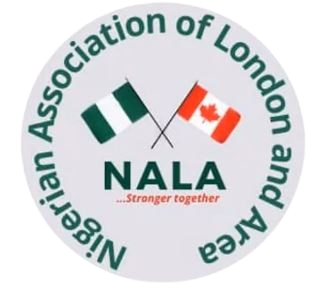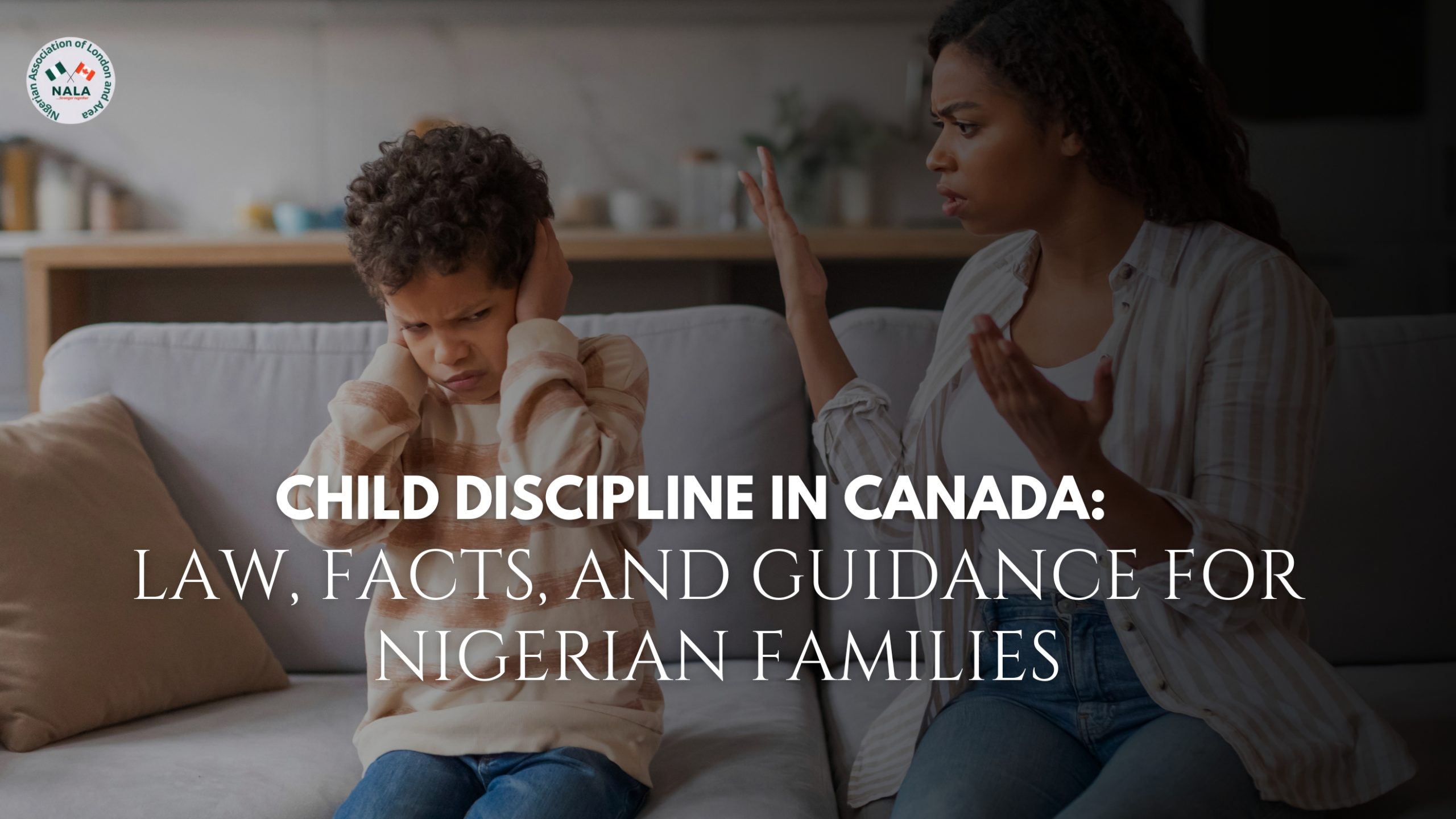Child Discipline in Canada: Law, Facts, and Guidance for Nigerian Families.
Canadian Legal Framework on Discipline
Criminal Code (Federal) – Section 43 provides that a parent may use “force by way of correction” if reasonable. However, the Supreme Court (2004) ruled this is narrowly limited. Only minor, transitory force is allowed: for example, a quick swat on the buttocks (without injury) may be legal, but any smack or slap hard enough to leave a mark or bruise is not permitted. The Justice Canada summary notes specifically that parents may only use “transitory and trifling” corrective force. Under no circumstances may one use objects (belts, sticks, rulers) or hit a child’s head or face. Likewise, force may not be used on toddlers under 2 or on most youth over about age 12. Any punishment that is degrading, humiliating or harmful exceeds “reasonable” force. In sum, Canadian law allows only very light spanking; anything beyond a gentle tap (no implements, no hits to the head, no lasting pain) is treated as assault/abuse.
Ontario Child Protection Law – Under Ontario’s Child, Youth and Family Services Act, a child is deemed “in need of protection” if they have suffered physical harm from their caregiver’s actions or are at risk of suffering harm. For example, the law specifies a child is at risk if “they suffered from physical harm because of what a parent did”. This means that excessive discipline causing injury, or repeated harsh physical punishment, can legally trigger a Children’s Aid Society (CAS) investigation. As one legal info guide notes, if force used “slips into abusive, harmful or degrading conduct,” it can result in criminal charges or child protection intervention. In practice, London and other Ontario agencies will intervene whenever a child is believed to be hurt by discipline. A fast way to involve CAS is any spanking that causes bruises, cuts or welts – these are considered physical abuse under Ontario law. (In fact, a 2019 Ontario case noted that even leaving bruises from spanking would be unlawful.) Teachers, doctors and other professionals are mandatory reporters: if they suspect a child was beaten or harmed, they must report it.
Cultural Context: Nigerian Practices vs Canadian Norms
In many Nigerian families, corporal punishment is a common and accepted form of discipline. Studies note that Nigerian parents often lack familiarity with non-violent methods and “rely too heavily on the use of violent methods” when children misbehave. For example, caning or hard spanking with a belt might be seen as normal corrective action in Nigeria. By contrast, Canadian society and law take a much stricter view. Even a moderate beating viewed at home as “okay” can be seen as abuse here. For instance, using a cane, belt or stick on a child – commonplace in some Nigerian traditions – is strictly prohibited in Canada. Similarly, shouting at or threatening a child in a humiliating way (e.g. calling names or scaring them) is strongly discouraged.
Importantly, Canadian authorities emphasize teaching over punishing. The Canadian Pediatric Society states that “the goal of discipline is to guide and teach, not to punish,” and it explicitly warns that “physical punishment… can hurt children both physically and emotionally, and should never be used. There are much more effective ways to discipline children”. Nigerian parents may find this surprising, since in Nigeria spanking or even slapping is often done out of love or concern. However, in Canada the line between “discipline” and “abuse” is thin. Any physical punishment that injures or deeply frightens a child is considered abuse.
Key Differences
-
Objects are never allowed: In Nigeria a parent might use a paddle or cane. In Canada hitting a child with any object (belt, stick, hairbrush, etc.) is absolutely prohibited.
-
No hitting the head/face: Even a light slap on a child’s head or face is illegal.
-
No bruises or injuries: Hitting that leaves bruises, welts or cuts will almost certainly be judged unreasonable.
-
No anger-driven punishment: Yelling or hitting out of frustration is not allowed. Discipline must be calm, purposeful and non-humiliating.
These norms can catch newcomers off-guard. A common misunderstanding is believing “It’s okay to spank my child as long as I don’t really hurt them.” In Canadian law, the focus is on how the force is applied and its effect. For example, spanking a 3‑year‑old with moderate force might be legal, but doing the same to a 10‑year‑old (when older children should be disciplined by discussion) would not be considered “reasonable”. Moreover, Nigerian parents may not realize that even a seemingly light punishment – like a few whacks with a belt that leave a mark – would be unacceptable here. Such myths can lead to a parent unintentionally committing a criminal offence or provoking a child welfare intervention.
Disciplining Children: Do’s and Don’ts
| Do (Acceptable Discipline) | Don’t (Unacceptable Discipline) |
|---|---|
| Use calm, verbal reasoning. Explain rules and consequences in words. | Hit or slap a child’s head, face or neck |
| Give brief time-outs (short periods of separation) for misbehavior. | Use objects (belt, cane, stick, spoon, hairbrush, etc.) to hit a child |
| Remove privileges (e.g. no TV, toys, outings) when rules are broken. | Spank or slap hard enough to bruise or mark the child |
| Praise and reward good behavior (stickers, treats, extra playtime). | Shake, throw, or push a child roughly |
| Use natural or logical consequences (e.g. clean up a mess they made). | Humiliate, intimidate or threaten a child (e.g. name-calling, scary threats). |
| Stay calm and consistent. Keep routines and rules clear. | Discipline in anger or frustration (acting out aggression on a child). |
Above all, discipline in Canada should teach, not harm. Even within the legal “spanking defence,” any discipline must be reasonable and minimal. If in doubt, avoid physical punishment altogether.
Alternatives to Physical Punishment
Given the strict limits, parents are encouraged to use positive strategies. The goal is to change behavior through guidance, not pain Effective alternatives include:
-
Firm but loving verbal correction: Speak calmly and explain why the behavior is wrong. Use “I” statements (e.g. “I’m upset when you draw on the wall”) instead of threats.
-
Time-Outs: Have the child sit quietly for a minute or two to calm down. (A common rule is “one minute per year of age.”)
-
Withdraw privileges: For misbehavior, temporarily take away a favorite toy, screen time or outing. Be sure this is communicated clearly beforehand.
-
Positive reinforcement: Notice and praise good behavior frequently. For example, reward sharing or chores with extra playtime or a small reward.
-
Natural consequences: Let children experience reasonable outcomes (e.g. if they scatter toys, they help clean them up). This helps them learn responsibility.
-
Distraction and redirection: With very young children, redirect their attention to something else when they act out.
-
Teach problem-solving: For older kids, involve them in finding solutions to their behavior (“What do you think you could do differently next time?”).
-
Emotional connection: Show affection and attention regularly. A strong parent-child bond makes discipline more effective.
Research shows these methods teach children self-control and respect without fear. Many Ontario agencies and community programs (e.g. Triple P Parenting, family counselling, or parenting classes offered through public health and schools) can provide training in positive discipline.
Common Pitfalls and Misunderstandings for Nigerian Immigrants
-
“They grew up this way!” Parents may believe “we were spanked at home and turned out fine.” In Canada, even if parents themselves were hit, they must now follow local norms.
-
Using a belt or stick “lightly”. Any implement used for hitting violates the law. Even a few swats with a belt can appear abusive.
-
Cultural or religious justifications. Invoking culture or religion (“it’s our tradition” or “the Bible says so”) is not recognized as a legal defense if a child is harmed.
-
Hitting out of frustration. Discipline done in anger is especially dangerous and not protected. Parents must control their temper.
-
Age limits. Spanking teens or older children (over ~12) is not allowed. The law expects issues with older kids to be handled by discussion, privileges or professional help.
-
Language barriers. Children must understand the correction. Yelling at a young child in a language they don’t fully know risks upsetting them without explanation.
-
Expecting leniency. Some parents think social services will turn a blind eye to mild spanking. In fact, any doubt of injury or neglect must be reported.
In all cases, the best approach is to assume Canadian rules are stricter than in Nigeria. If unsure, err on the side of gentleness. Remember that child welfare workers aim to keep families together whenever possible; they will often first offer parental education rather than removal. Learning Canada’s discipline norms before a problem arises is the safest course.
Summary: In Canada, laws (federal and Ontario) permit only very mild physical discipline. Hitting that injures, humiliates or uses objects is always unlawful. Nigerian parents should therefore adopt positive, non-violent discipline strategies. In practice, this means talking through misbehavior, using time-outs or privilege withdrawal, and emphasizing guidance over force. By understanding Canadian laws and using these alternatives, parents can correct children effectively without risking legal problems or child welfare intervention.
Sources: Ontario’s Child Incidence Study and Children’s Aid policy oacas.orgcaslondon.on.ca; Canadian Criminal Code and Supreme Court interpretations justice.gc.cajustice.gc.ca; Justice Canada guidance lop.parl.cajustice.gc.ca; Ontario legal definitions of “in need of protection”stepstojustice.ca; and expert parenting guidance from Canadian health authorities caringforkids.cps.ca, among others. These official sources make clear the above rules and recommendations.


3 Responses
This was an interesting read. Hmm lots of things to note and be aware of. Thanks for sharing
hmmm, learning never really stops, does it? Every discovery has the potential to shift perspectives, refine ideas, and spark new insights.
It’s always fascinating to see how moments of realization shape understanding.
Thanks for sharing.
You are so right. We keep learning.